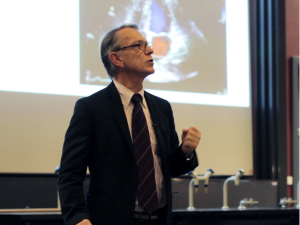Research done in southern Sweden shows that three blood biomarkers of selenium availability correlated inversely with mortality from breast cancer. The lower the three selenium biomarker levels, the higher the mortality [Demircan 2021].

The blood biomarkers are:
- Total selenium
- Selenoprotein P
- Glutathione peroxidase 3
Breast cancer patients with blood concentrations of these three selenium biomarkers in the highest quintile had significantly better chances of survival compared with patients whose blood levels of these substances were in the lowest quintile [Demircan 2021].
Breast cancer patients with low selenium status according to these three biomarkers had the highest mortality risk with an overall survival probability of approximately 50% after 8 years. The difference in survival between the breast cancer patients in the lowest selenium quintile compared to breast cancer patients with at least one biomarker in the highest quintile was especially notable [Demircan 2021].
Bottom line: Prediction of survival based on the three selenium-related biomarkers outperformed prediction of survival based on established tumor characteristics – histologic grade, number of involved lymph nodes, tumor size [Demircan 2021].
The Sweden Cancerome Analysis Network – Breast Initiative
The Sweden Cancerome Analysis Network – Breast Initiative (SCAN-B Study) is a large prospective cohort study of patients from several participating hospitals. The primary analysis summarized in this article was based on blood sample data from 1996 patients who had just received a new diagnosis of primary invasive breast cancer. The blood sampling took place at the time of diagnosis. Researchers analyzed the total selenium, the selenoprotein P, and the glutathione peroxidase 3 in the serum of the blood drawn from the breast cancer patients [Demircan 2021].
Selenium and Selenoproteins
Fact: Low concentrations of serum selenium, selenoprotein P, and glutathione peroxidase 3 are associated with a poor prognosis following a breast cancer diagnosis [Demircan 2022].
Fact: Selenium is a trace element that is essential for life, first and foremost through the activities and effects of the selenoproteins for which it is an active component. Sufficient selenium intakes and status are necessary for maintaining good health and for avoiding disease. Selenoprotein P is the primary selenium transporter in the body. Without adequate selenoprotein P, the body tissues and organs do not get enough selenium.
Fact: Glutathione peroxidase 3 is an important antioxidant. GPx-3 is a member of the glutathione peroxidase family of selenoenzymes. It is an extracellular selenoenzyme that protects the cells against oxidative damage, i.e., damage done by harmful free radicals. Generally, selenium intakes that optimize the activity of selenoprotein P are sufficient to optimize the activity of the glutathione peroxidases [Hurst 2010].

Fact: A good estimate is that a selenium status of 120 mcg/L, when measured in the red blood cells, is necessary for the optimal activity of important selenoenzymes [Alehagen 2022].
Fact: An intake of 100-150 mcg/day of selenium seems to be necessary for the optimal expression of selenoprotein P [Alehagen 2022].
Selenium Intakes in Selenium-Poor Regions of the World
The significance of selenium for the breast cancer outcomes in the Scan-B Study takes on importance when we consider that women in Sweden generally get less than optimal amount of selenium in their diets.
In a study of 688 elderly Swedish citizens living in southeastern Sweden, Prof. Urban Alehagen and a team of researchers were able to establish that the mean serum selenium concentration was 67.1 mcg/L, well below the optimal level [Alehagen 2022].
Conclusion: Selenium Status and Breast Cancer Prognosis
Assessment of serum selenium, serum selenoprotein P, and serum glutathione peroxidase 3 levels at the time of diagnosis can identify breast cancer patients at risk of a poor prognosis for survival.
Breast cancer patients with low serum selenium and selenoprotein concentrations may respond favorably to selenium supplementation.
A 2014 study has shown that supplementation with a selenized yeast product significantly reduced the levels of blood biomarkers for oxidative stress; supplementation with a pure selenomethionine product did not. These findings suggest that selenium-enriched yeast products contain selenium species other than selenomethionine that are responsible for the reduction in the extent of oxidative damage [Richie 2014].
Sources
Alehagen U, Johansson P, Svensson E, Aaseth J, Alexander J. Improved cardiovascular health by supplementation with selenium and coenzyme Q10: applying structural equation modelling (SEM) to clinical outcomes and biomarkers to explore underlying mechanisms in a prospective randomized double-blind placebo-controlled intervention project in Sweden. Eur J Nutr. 2022 Apr 6. doi: 10.1007/s00394-022-02876-1. Epub ahead of print.
Demircan K, Bengtsson Y, Sun Q, Schomburg L et al. Serum selenium, selenoprotein P and glutathione peroxidase 3 as predictors of mortality and recurrence following breast cancer diagnosis: A multicentre cohort study. Redox Biol. 2021 Nov;47:102145.
Demircan K, Sun Q, Bengtsson Y, Schomburg L et al. Autoimmunity to selenoprotein P predicts breast cancer recurrence. Redox Biology. 2022;53:102346.
Hurst R, Armah CN, Dainty JR, Hart DJ, Teucher B, Goldson AJ, Broadley MR, Motley AK, Fairweather-Tait SJ. Establishing optimal selenium status: results of a randomized, double-blind, placebo-controlled trial. Am J Clin Nutr. 2010 Apr;91(4):923-31.
Richie JP Jr, Das A, Calcagnotto AM, El-Bayoumy K et al. Comparative effects of two different forms of selenium on oxidative stress biomarkers in healthy men: a randomized clinical trial. Cancer Prev Res (Phila). 2014 Aug;7(8):796-804.
The information presented in this review article is not intended as medical advice and should not be used as such.
30 June 2022
